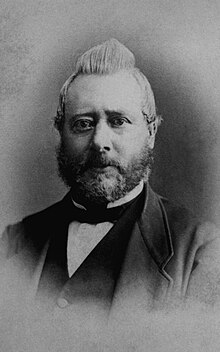Pieter Bleeker (original) (raw)
From Wikipedia, the free encyclopedia
Dutch medical doctor (1819–1878)
| Pieter Bleeker | |
|---|---|
 |
|
| Born | (1819-07-10)10 July 1819Zaandam, the Netherlands |
| Died | 24 January 1878(1878-01-24) (aged 58)The Hague, the Netherlands |
| Known for | Atlas Ichthyologique des Indes Orientales Néêrlandaises |
| Awards | Doctorates honoris causa at Leyden University and Utrecht University, Légion d'honneur |
| Scientific career | |
| Fields | HerpetologyIchthyologyTropical medicine |
| Institutions | Royal Netherlands Academy of Arts and SciencesNational Museum of Natural History (France)Royal Netherlands Institute of Southeast Asian and Caribbean Studies |
| Author abbrev. (zoology) | Bleeker |
Pieter Bleeker (10 July 1819 – 24 January 1878) was a Dutch medical doctor, ichthyologist, and herpetologist. He was famous for the Atlas Ichthyologique des Indes Orientales Néêrlandaises, his monumental work on the fishes of East Asia published between 1862 and 1877.
Bleeker was born on 10 July 1819 in Zaandam.[1] He was employed as a medical officer in the Royal Netherlands East Indies Army from 1842 to 1860,[2] stationed in the Dutch East Indies (now Indonesia). During that time, he did most of his ichthyology work, besides his duties in the army. He acquired many of his specimens from local fishermen, but he also built up an extended network of contacts who would send him specimens from various government outposts throughout the islands. During his time in Indonesia, he collected well over 12,000 specimens, many of which currently reside at the Naturalis Biodiversity Center in Leiden.[3] Bleeker corresponded with Auguste Duméril of Paris. His work in ichthyology and tropical medicine was recognised by two doctorates honoris causa (Leyden University, 1846; Utrecht University, 1849).[2]
After his return to the Netherlands in 1860, he started publishing the Atlas Ichthyologique des Indes Orientales Néêrlandaises, a comprehensive account of his studies done in Indonesia, featuring over 1,500 illustrations. It was published in 36 volumes between 1862 and his death in 1878.[2] Between 1977 and 1983, the Smithsonian republished the work in 10 volumes.
Bleeker published more than 500 papers on ichthyology, describing 511 new genera and 1,925 new species.
He also worked in herpetology, describing at least 14 species of reptiles,[4][5] most of them described in Reptilien van Agam.[6]
In 1855, he became correspondent of the Royal Netherlands Academy of Arts and Sciences, department Natuurkunde (then Natural Sciences), and in 1862 a member.[1] In 1856, he was elected correspondent for the Muséum national d'histoire naturelle in Paris. In January 1864 he received a French knighthood of the Légion d'honneur.[2] He was president of the Royal Netherlands Institute of Southeast Asian and Caribbean Studies.[1]
Bleeker died on 24 January 1878 in The Hague.[1]
Taxa named in his honor
[edit]
Fish named after him include:
- Osteochilus bleekeri is a species of cyprinid fish endemic to Borneo and Sumatra.[7]
- The Stone Loach Triplophysa bleekeri (Sauvage & Dabry de Thiersant, 1874)
- Argyrops bleekeri Oshima, 1927[8]
- Chlorurus bleekeri, known commonly as Bleeker's parrotfish, is a species of marine fish in the family Scaridae.
Taxa described by him
[edit]
- ^ a b c d "Pieter Bleeker (1819 - 1878)". Royal Netherlands Academy of Arts and Sciences. Archived from the original on 15 July 2020.
- ^ a b c d van Heiningen TW (2010). "[Pieter Bleeker (1819-1878) physician and passionate naturalist]". Histoire des sciences médicales. 44 (3): 257–267. PMID 21560380. (in French).
- ^ "Naturalis Topstukken". topstukken.naturalis.nl (in Dutch). Retrieved 2021-04-08.
- ^ Bleeker P (1860). "Over de Reptiliën-fauna van Sumatra". Natuurkundig Tijdschrift voor Nederlandsch Indië. 21: 284–298. (in Dutch).
- ^ The Reptile Database
- ^ Bleeker P (1860). Reptilien van Agam. Natuurkundig Tijdschrift voor Nederlandsch Indie, Batavia 20: 325-329. (in Dutch).
- ^ Froese, Rainer; Pauly, Daniel (eds.). "Osteochilus bleekeri". FishBase. November 2014 version.
- ^ Christopher Scharpf & Kenneth J. Lazara (22 September 2018). "Order SPARIFORMES: Families LETHRINIDAE, NEMIPTERIDAE and SPARIDAE". The ETYFish Project Fish Name Etymology Database. Christopher Scharpf and Kenneth J. Lazara. Retrieved 29 April 2022.
- ^ Christopher Scharpf & Kenneth J. Lazara (22 September 2018). "Order LABRIFORMES: Family LABRIDAE (a-h)". The ETYFish Project Fish Name Etymology Database. Christopher Scharpf and Kenneth J. Lazara. Retrieved 27 February 2023.
- [Beolens B](/wiki/Richard%5FAllen%5F%22Bo%22%5FCrombet-Beolens "Richard Allen "Bo" Crombet-Beolens"), Watkins M, Grayson M (2011). The Eponym Dictionary of Reptiles. Baltimore: Johns Hopkins University Press. xiii + 296 pp. ISBN 978-1-4214-0135-5. ("Bleeker", p. 28).
- P. Bleeker, Levensbericht in: Jaarboek, 1877, Amsterdam, pp. 5-159 (Autobiography of Bleeker with an introduction by Pieter Harting). (in Dutch).
- Bleeker P, van Oijen MJ, Loots GM, van Limburg FJ (2009). "A precursor of the fish of the Indian Archipelago. Part 1: Siluri". Zoologische Mededelingen. 83: 1–317.
- Norman D, Whitehead PJ (1984). "The Bleeker/Günther letters and the sale of Bleeker specimens to the British Museum". Zoologische Mededelingen. 58: 295–312.
- Whitehead PJ, Boeseman M, Wheeler AC (1966). "The types of Bleeker's Indo-Pacific Elopoid and Clupeoid Fishes". Zoologische Verhandelingen. 84: 1–152.


